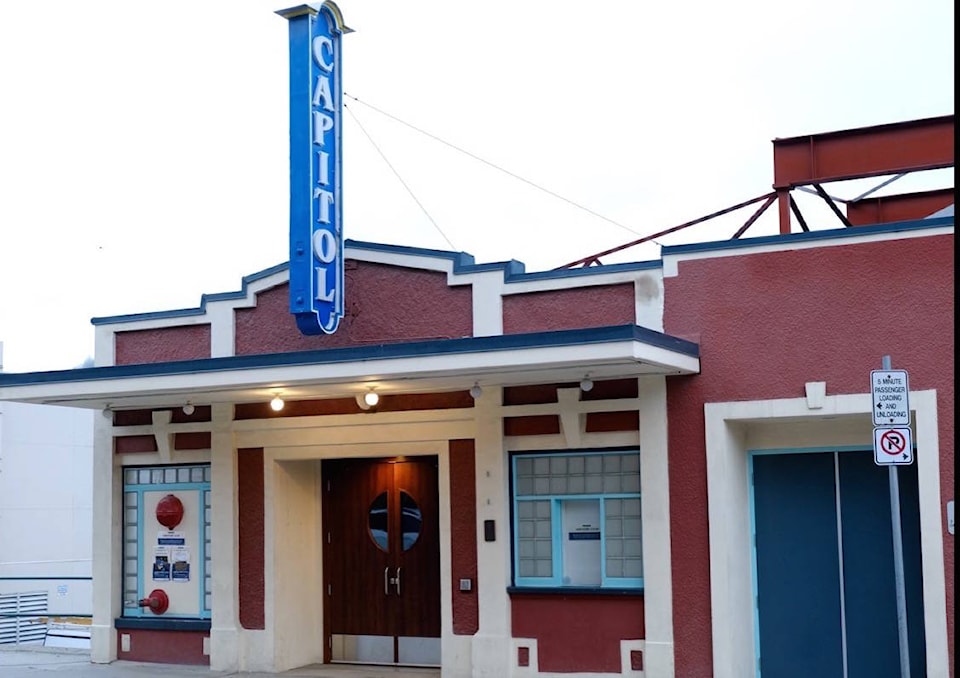Justice Catherine Murray looks like the lead actor in a stage play.
She is professionally lit, the sound is clear, she speaks her lines confidently and clearly, and the set designer has done a good job of replicating the furnishings and technology of a courtroom.
The other actors on the stage do a convincing job of portraying two prosecutors, two defence lawyers, court staff, and an accused person on trial.
The audience is small: just 13 people, spaced far from each other throughout the ground level of Capitol Theatre seating.
But those people are jurors, and this is no play. It’s the manslaughter trial of RCMP Const. Jason Tait that began on Sept. 28, taking place in the Capitol Theatre over the next five weeks because the regular courtroom at the Nelson Courthouse could not accommodate a physically distanced jury in a pandemic.
“The only venue that met the requirements of a court facility (including counsel stand down rooms, jury box, public gallery, judges chambers and other considerations including proximity to accommodation and possible jury deliberation sites, courthouse, security etc.) was the Capitol Theatre,” a spokesperson for the Attorney General’s office told the Star last month.
Another part of the “audience” for this courtroom drama are members of the families of Tait and the man who died, Waylon Edey. They are seated at either end of the raised back section of seats in the theatre.
Otherwise there is room only for the media and a handful of members of the public, who are carefully screened on entry by staff of the B.C. Sheriff Service, and whose route in and out of the building is strictly mapped out.
Every member of theatre and court staff is wearing a mask, as are most of the people on stage most of the time. The witness table on the stage will be disinfected by court staff between witnesses.
To begin the trial, prosecutor Cory Lo outlined to the jury the case the prosecution intended to prove.
He said that on Jan. 29, 2015, the RCMP was given the licence number of a pickup driven by an intoxicated person near Castlegar. Police identified the driver as Edey, a prohibited driver with multiple convictions for impaired driving.
Tait located the vehicle, followed it with his siren on, passed it, and then pulled his car across the westbound lane, blocking the pickup. He then got out of his car and stood in the eastbound lane with his gun aimed at Edey’s vehicle.
Edey did not stop, but drove into the eastbound lane, Lo said. Tait fired four shots at Edey’s vehicle, one of which struck Edey in the head.
“Policing can be a dangerous and difficult profession,” Lo told the jury. “And the law recognizes that police officers sometimes need to use force in the execution of their duty. However this allowable use of force is not unlimited. Police officers may only use force in a manner that is reasonable, necessary and proportionate to the circumstances.”
Lo conceded that Tait had a duty to respond to the impaired driving call, and that Tait knew Edey had a criminal record. But Tait’s actions were contrary to police policy, he said.
“It was extremely dangerous for Const. Tait to use his own vehicle to unexpectedly block Mr. Edey . . . This was dangerous to Mr. Edey, to other users on the highway and to Const. Tait himself.
“Furthermore his decision to confront Mr. Edey on foot, which led directly to the shooting, was unnecessary. Const. Tate’s actions, when viewed as a whole, are unreasonable and unjustified and not permitted by law.”
Lo said the prosecution will provide evidence to back up this theory during the trial, including photos, diagrams, documents and a police dash-cam video.
Witnesses for the prosecution, he said, will include investigators at the Independent Investigations Office, RCMP officers, RCMP trainers, drivers who witnessed the event, experts in traffic collision and reconstruction, experts in assessing appropriate use of force, a firearms analyst, and a pathologist.
“My comments are not to be taken as evidence by themselves,” Lo told the jury. “It is your duty to examine the evidence that is called and come to an independent determination of the facts.”
One of the reasons this matter has taken so long to come to trial is that it was investigated by the Independent Investigations Office (IIO), which investigates any situation in which a person is injured or killed by a police officer. IIO investigations and decisions are famously slow.
After its investigation the IIO recommended to Crown that Tait be charged with manslaughter.
Justice Murray told the jury that she had chosen 17 jury members in the anticipation that the numbers might drop, and that in fact now there were only 13 because three had reported suspected COVID-19 symptoms. She said there is still one to spare, and that at the end of the trial only 12 will be allowed to deliberate on the verdict.
She instructed them in the COVID-19 protocols of the courtroom and in how to approach the evidence. Her main message was not to jump to conclusions during the trial, but to keep an open mind until the end.
She explained that if they find Tait guilty it must be beyond a reasonable doubt.
“Probably guilty” does not meet that standard, she said.
She explained that Tait is now considered innocent, and that it is the Crown’s job to prove his guilt.
“Const. Tait does not have to prove anything,” she said.
